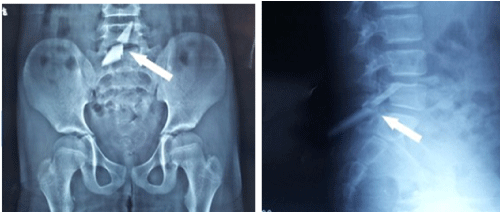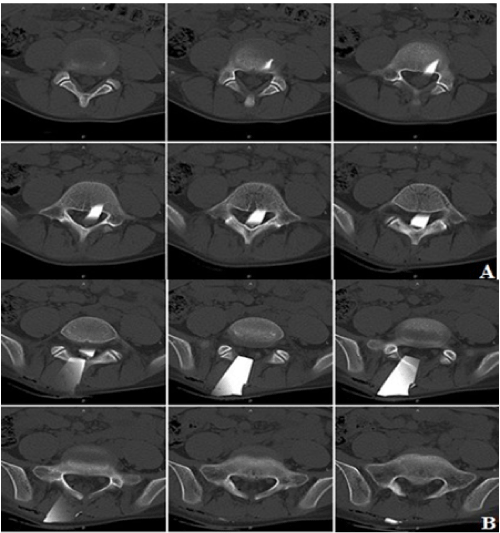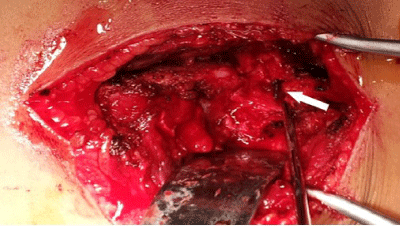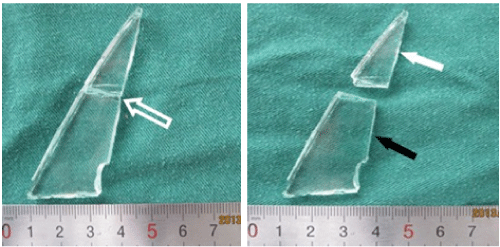Case Report Open Access
Pediatric Penetrating Spinal Canal Injury by Glass Cutting caused Cauda Equina Syndrome: Case Report and Literature Review
| Tian Da-sheng2, Zhu Bin2, Zhang Shi-jia2 and Jing Jue-hua1* | |
| 1Department of Orthopaedics, Second Hospital, Affiliated to Anhui Medical University, Hefei, China | |
| 2Section of Nephrology and Hypertension, Department of Medicine, Tulane University School of Medicine, Tulane Ave, New Orleans, USA | |
| Corresponding Author : | Jing Jue-hua Department of Orthopaedics Second Hospital Affiliated to Anhui Medical University, Hefei, China Tel: +86 551 6386 9119 Email: 281885472@qq.com |
| Received: September 29, 2015 Accepted: November 12, 2015 Published: November 19, 2015 | |
| Citation: Da-sheng T, Bin Z, Shi-jia Z, Jue-hua J (2015) Pediatric Penetrating Spinal Canal Injury by Glass Cutting caused Cauda Equina Syndrome: Case Report and Literature Review. J Preg Child Health 2:205. doi:10.4172/2376-127X.1000205 | |
| Copyright: © 2015 Da-sheng T, et al. This is an open-access article distributed under the terms of the Creative Commons Attribution License, which permits unrestricted use, distribution, and reproduction in any medium, provided the original author and source are credited. | |
| Related article at Pubmed, Scholar Google | |
Visit for more related articles at Journal of Pregnancy and Child Health
Abstract
A 9-year-old girl was stabbed by aquarium glass fragments in her back, which entered adjacent to the S1 vertebra and stayed within the spinal canal adjacent to the L5 vertebra. Surgical removal of the glass fragments in the acute phase was performed to decrease the risks of delayed complications associated with the presence of the sharp and pointed glass inside the spinal canal and cauda equina and nerve roots compression. Surgical intervention should be considered in patients with evolving neurologic deficits with the goal of decompressing the spinal cord and optimizing the recovery of function.
|
Abstract
A 9-year-old girl was stabbed by aquarium glass fragments in her back, which entered adjacent to the S1 vertebra and stayed within the spinal canal adjacent to the L5 vertebra. Surgical removal of the glass fragments in the acute phase was performed to decrease the risks of delayed complications associated with the presence of the sharp and pointed glass inside the spinal canal and cauda equina and nerve roots compression. Surgical intervention should be considered in patients with evolving neurologic deficits with the goal of decompressing the spinal cord and optimizing the recovery of function.
Keywords: Spinal canal injury; Pediatric; Glass; Cauda equina syndrome Introduction
Penetrating injuries of the spine canal caused by foreign bodies are uncommon in the pediatric emergency departments [1,2]. Very few cases relating to the cauda equina syndrome (CES) caused by stab wounds have been reported. Such injuries represent distinct pathogenetic mechanisms that require unique surgical considerations [3-5]. We present a unique case of a 9-year-old girl, who was stabbed in the back with a piece of aquarium glass reaching the spinal canal. She had very mild neurological complaints, no neurological deficits on examination, and no evidence of spinal fracture or instability. This article reports the clinical course, discusses the problems met during surgery, and reviews relevant reports regarding this uncommon condition.
Case Report
A 9-year-old girl was brought into the emergency room after she suffered a cutting wound by a large piece of glass from a broken aquarium at home. The entrance wound was located dorsolaterally and was adjacent to the S1 vertebra. There was only a 4-cm visible entry wound, and radiological investigations revealed that the glass had lodged within the spinal canal between L5 and S1 level (Figure 1). Her primary complaint was initially some pain at the entrance wound. With detailed questioning, she did complain of mild subjective numbness in her perineum. Her neurological examination, including sensation, was normal. She had no other systemic complaints, and there was no evidence of any abdominal or perineum injury.
Preoperative evaluation
Upon presentation to the emergency room, a 4-cm irregular cut wound was noted in the right para-vertebral region at the level of the first sacral vertebrae (S1). A moderate swelling was noticed around the wound. There was no active bleeding or pathological secretion on initial evaluation. She had intact sensation to light touch and pin prick in all the dermatomes. She had 5 out of 5 motor strength in all muscle groups in both lower extremities. A radiograph of the patient’s lumbosacral spine was obtained, and a 5-cm-long triangularly shaped density was detected. It projected into the spinal canal between the spinous processes of L5 and S1 broke into two pieces (Figure 1). Computed tomography (CT) of the lumbar spine demonstrated that the glass fragment extended into the spinal canal between the spinous processes of S1 and L5 with its tip at the upper L5 level (Figure 2).
Operative technique
The patient received standard gram-positive peri-operative antibiotic coverage (cefazolin) and tetanus toxoid administration. She underwent general anesthesia in the prone position. A midline incision incorporating the cutting wound was made. A right para- vertebral tract extending from the lamina of S1 to the lamina of L5 was noted. The stuck trapezoid-shaped glass was identified within the muscle and removed. Then a bilateral hemilaminotomy was performed at L5. Due to the patient’s young age, effort was made to minimize bony resection as much as possible and to spare the facet joints to avoid the development of post-surgical deformity.Left L5 laminectomy revealed an 11-mm dural tear. A triangle-shaped glass was identified within the spinal canal between the nerve roots and removed carefully (Figure 3 and 4). The nerve roots at this level were intact. The dural tear was repaired using a combination of “0” silk and fibrin glue. After careful hemostasis, a quantity of normal saline was used for space irrigation to eliminate residual tissue and blood clot. Then a drainage tube was set up, and the incisions were closed.
Postoperative care
The drainage tube was removed when the drainage volume dropped below 50 ml 48 hours postoperative. A supine position was maintained for 24 hours post operatively, and intravenous antibiotics were continued for 7 days. Over this period of time, the patient’s neurologic examination remained within normal limits. The patient had no numbness in her perineum but continued to be dependent on the urinary catheter. The patient was subsequently discharged to a specialist rehabilitation center on post-operative day 7.
Discussion
To our knowledge, the incidence of glass penetrating spinal cord injury is rare [1,2]. There are quite limited reported cases of penetrating spinal canal injury by a glass fragment in pediatric patients. In 1931 Topliff and Daly [6] described a case of a 2-year-old girl, who fell backwards and was cut in her back with a piece of glass, penetrating her spinal canal. She contracted meningitis but survived. Douglas and Opel [7] reported in 2004 that a 8-year-old boy suffered spinal canal penetration between the spinous processes of L1 and L2 by a glass picture frame that fell off the wall. The boy was neurologically stable, and all the healed well. In 2012 Yoshioka and Kawahara [8] reported a 12-year-old boy, in whom a piece of glass fragment migrated into the lumbar spinal canal causing low back pain and radiculopathy, which was 6 years after the injury. Komarowska and Debek [9] described a Brown-Séquard syndrome case in 2013 that an 11-year-old girl had penetrating glass injury to the thoracic spine.
Our case differed from previous reports due to several reasons. The mechanism of injury was from the direct force of the sharp glass fragment that penetrated the lower lumbar para-spinal region. We believe that after piercing the skin and subcutaneous tissue, the piece of glass probably broke into two pieces. The trapezoid-shaped fragment remained superficially in the deep subcutaneous tissue overlying the lumbosacral fascia. However, due to the absence of natural protection of the bony structure of the vertebra plate in children, the triangle-shaped piece was pushed towards the left lamina of L5 and subsequently pierced into the dura to the vertebral body without damaging the nerve roots of the cauda equina. Accurate localization of a foreign body before removal is important because searching can be time-consuming and can cause further injury, especially in the spinal canal [10]. The type of foreign body suspected dictates which imaging modality to use. The density of glass in comparison to surrounding tissue almost always provides sufficient contrast for roentgenographic differentiation. Routine X-ray radiographs studies are a cheap yet effective modality for imaging glass, which could reveal almost all pieces of glass except for those obscured by bone [11-13]. The increased spatial and contrast resolution of CT improves the perspicacity of foreign bodies within the spinal canal. CT imaging is useful to elucidate the nature of bony injury and delineate the trajectory of the foreign bodies [14,15]. In our case, CT scans of the lumbar spine revealed that the triangle-shaped glass had pierced into the L5 vertebral level but there was no roots compression (Figure 2). The high soft tissue resolution and tissue characterisation capabilities of magnetic resonance imaging (MRI) are of use in the detection of non-metallic foreign bodies and associated spinal cord injury. However, if a ferromagnetic fragment is present, MRI can be potentially dangerous. The high magnetic fields are likely to dislocate the metallic fragment and cause unpredicted neurological deficits [16]. The treatment strategy of such injuries involves surgery to remove the foreign body due to the potential risks, including infection, migration of the glass, and further injury during the movement [17-19].The decision to proceed with spinal surgery in our patient was based on the evolving neurologic exam as well as concerns for cauda equina and nerve roots compression and cerebrospinal fluid leak. However, surgery at the cauda equina, in such cases, may be difficult due to the dural tear that is associated with impingement of the contused nerve roots with the glass fragment. Cauda equina lesions carry a better functional prognosis than spinal cord injuries. Recovery, however, is unpredictable. Age, energy transfer to the neurovascular structures, and timing of decompression may all play a role [20,21]. In this case, damage produced by penetrating injuries is probably not from the persistent compression from foreign bodies or bony fragments, but from the immediate events at impact, the peripheral nerves of the cauda equina transection, or disruption of cauda equina vasculature with consequent ischemia. Although we could not repair the cauda equina rootlets, our patient had excellent symptomatic relief of her back pain and perineal numbness. While post-void residual incontinence persisted until the patient was discharged, we would have to wait and see if this improves in the future. Conclusion
Management of children spinal canal foreign bodies can be challenging. There are not enough clinical data to establish a guideline for management of this type of injury.
Therefore, the treatment should be individualized. Surgical intervention should be considered in patients with evolving neurologic deficits with the goal of decompressing the spinal cord in order to optimize recovery of function. |
References
- National Spinal Cord Injury Statistical Center (NSCISC) (2012) Spinal cord injury: facts and figures at a glance. Birmingham (AL) 35: 68–69.
- Ajit Singh MS, Nishant Goyal (2011) An overview of spinal injuries in children: Series of 122 cases. The Indian Journal of Neurotrauma 8: 25–32.
- Pal D, Timothy J, Marks P (2006) Penetrating spinal injury with wooden fragments causing cauda equina syndrome:case report and literature review. Eur Spine J 15: 574-577.
- Robertson DP, Simpson RK (1992) Penetrating injuries restricted to the cauda equina: a retrospective review. Neurosurgery 31: 265-270.
- Harrop JS, Hunt GE Jr, Vaccaro AR (2004) Conus medullaris and cauda equina syndrome as a result of traumatic injuries: management principles. Neurosurg Focus 16: e4
- Topliff E, Daly J (2002) Accidental puncture of the cerebrospinal canal. CMAJ 1931:836-838.
- Opel DJ, Lundin DA (2004) Glass foreign body in the spinal canal of a child: case report and review of the literature. PediatrEmerg Care 20: 468-472.
- Yoshioka K, Kawahara N (2012) A glass foreign body migrating into the lumbar spinal canal: a case report. J OrthopSurg (Hong Kong) 20: 257-259.
- M Komarowska, W Debek (2013) Brown-Séquard syndrome in a 11-year-old girl due to penetrating glass injury to the thoracic spine. Eur J OrthopSurgTraumatol 23: 141–143.
- Ben-Galim P, Reitman CA (2008) Intrathecal migratory foreign body without neurological deficit after a gunshot wound. Spine J 8: 404-407.
- Fordham SD (1976) The detection of glass foreign bodies. South Med J 69: 1484-1485.
- O’Driscoll SW (1988) Glass is detectable on plain radiographs. CMAJ 139: 643-644.
- Felman AH, Fisher MS (1969) The radiographic detection of glass in soft tissue. Radiology 92: 1529-1531.
- Humphrey G, Super P, Dalton M (1993) Retained glass foreign bodies:confirmation and localization by computerized tomography and ultra-sonography. Injury 24: 493-494.
- Bodne D, Quinn SF, Cochran CF (1998) Imaging foreign glass and wooden bodies of the extremities with CT and MR. J Comput Assist Tomogr. 12: 608-611.
- James CA, Karacozoff A (2013) Undisclosed and undetected foreign bodies during MRI screening resulting in a potentially serious outcome. MagnReson Imaging 31: 630-633
- Gulamhuseinwala N, Terris J (2004) Evolving presentation of spinal canal penetrating injury. Injury 35: 908-912.
- Skadorwa T, Ciszek B (2013) Pediatric arrowshot injury to cervical spinal cord-sagittal cord transection with no neurological deficit and good outcome: case report and review of literature. Childs NervSyst 29: 1933-1939.
- Manzone P, Domenech V, Forlino D (2001) Stab injury of the spinal cord surgically treated. J Spinal Disord 14: 264-267.
- Hamilton MG, Myles ST (1992) Pediatric spinal injury: review of 174 hospital admissions. J Neurosurg 77: 700-704.
- Garcia RA, Gaebler-Spira D (2002) Functional improvement after pediatric spinal cord injury. Am J Phys Med Rehabil 81: 458-463.
Figures at a glance
 |
 |
 |
 |
| Figure 1 | Figure 2 | Figure 3 | Figure 4 |
Relevant Topics
Recommended Journals
Article Tools
Article Usage
- Total views: 9841
- [From(publication date):
December-2015 - Apr 21, 2025] - Breakdown by view type
- HTML page views : 8951
- PDF downloads : 890
